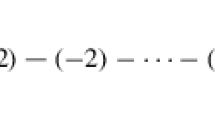Abstract
In this paper, we associate an invariant \(\alpha _{x}(L)\) to an algebraic point \(x\) on an algebraic variety \(X\) with an ample line bundle \(L\). The invariant \(\alpha \) measures how well \(x\) can be approximated by rational points on \(X\), with respect to the height function associated to \(L\). We show that this invariant is closely related to the Seshadri constant \(\epsilon _{x}(L)\) measuring local positivity of \(L\) at \(x\), and in particular that Roth’s theorem on \(\mathbb {P}^1\) generalizes as an inequality between these two invariants valid for arbitrary projective varieties.

Similar content being viewed by others
Notes
All uses of “Roth” as an adjective in this paper are in homage to the theorem proved by Klaus F. Roth and its later extensions by Ridout and Lang, and do not refer to the second named author of the paper.
The extra quantifier “\(C\)” in Definition 2.10 can be absorbed by the condition that the finiteness is supposed to hold for all \(\gamma <\alpha _x\). The purpose of this quantifier in Definition 2.10 is to simplify arguments.
To the best of our knowledge, the number \(\beta _x(L)\) was first defined by Per Salberger in unpublished work dating from 2006, where it was used to improve results of R. Heath-Brown on uniform upper bounds for the number of rational points of bounded height. Salberger also proved Corollary 4.2 as a key step in this work.
As well as Propositions 2.14 (f) and 3.4 (c), and Corollary 4.4...
If \(X\) is not normal, \(\Gamma (X,mL)\otimes _{k}K^{(v)}\) may only be a proper subspace of \(\Gamma (\widetilde{X}^{(v)},mL^{(v)}_{0})\). However, since the volume is a birational invariant, the asymptotic calculations go through without change and we omit further mention of this detail.
References
Bombieri, E., Gubler, W.: Heights in Diophantine Geometry, New Mathematical Monographs 4. Cambridge University Press, Cambridge (2006)
Boucksom, S., Favre, C., Jonnson, M.: Differentiability of volumes of divisors and a problem of Tessier. J. Algebr. Geom. 18(2), 279–308 (2009)
Choi, K.K.; Vaaler, J.D., Diophantine approximation in projective space, number theory. In: Ottawa: CRM Proceedings Lecture Notes, 19, American Mathematical Society, Providence, vol. 1999, pp. 55–65 (1996)
de Fernex, T., Küronya, A., Lazarsfeld, R.: Higher cohomology of divisors on a projective variety. Math. Ann. 337(2), 443–455 (2007)
Demailly, J.-P.: Singular Hermitian metrics on positive line bundles, complex algebraic varieties (Bayreuth, 1990). Lect. Notes Math. 1507, 87–104 (1992)
Faltings, G., Wüstholz, G.: Diophantine approximations on projective spaces. Invent. Math. 116, 109–138 (1994)
Hindry, M., Silverman, J., Diophantine Geometry. An Introduction. Graduate Texts in Mathematics, 201. Springer, New York (2000)
Küronya, A.: Asymptotic cohomological functions on projective varieties. Am. J. Math. 128(6), 1475–1519 (2006)
Lang, S.: Diophantine Geometry, Interscience Tracts in Pure and Applied Mathematics, No. 11. Wiley, New York, London (1962)
Lazarsfeld, R.: Positivity in Algebraic Geometry I, Springer, New York (2004)
Lazarsfeld, R., Mustaţă, M.: Convex bodies associated to linear series, Ann. Sci. Éc. Norm. Supér. 42 (4), 783–835 (2009) (no. 5)
Macintyre, A.: Non-standard number theory. In: Proceedings of international congress mathematics Helsinki, vol. 1, pp. 253–262 (1978)
McKinnon, D.: A conjecture on rational approximations to rational points. J. Algebr. Geom. 16, 257–303 (2007)
McKinnon, D., Roth, M.: An analogue of Liouville’s theorem and an application to cubic surfaces (submitted). arXiv:1306.2977
Neukirch, J.: Algebraic Number Theory. Springer, New York (1999)
Robinson, A., Roquette, P.: On the finiteness theorem of Siegel and Mahler concerning Diophantine equations. J. Number Theory 7, 121–176 (1975)
Schmidt, W.: Diophantine Approximation, Lecture Notes in Mathematics 785. Springer, Berlin (1980)
Serre, J.-P.: Lectures on the Mordell–Weil Theorem, Vieweg, Wiesbaden (1997)
Soulé, C., Abramovich, D., Burnol, J.-F., Kramer, J.: Lectures on Arakelov Geometry. Cambridge University Press, Cambridge (1994)
Vojta, P.: Diophantine Approximations and Value Distribution Theory, Lecture Notes in Mathematics, vol. 1239. Springer, Berlin (1987)
Acknowledgments
We thank Chris Dionne, Laurence Ein, Robert Lazarsfeld, Victor Lozovanu, and Damien Roy for helpful discussions. We are also extremely grateful to the referees of this paper for pointing out several mathematical and expositional errors in the initial versions, and for their suggestions on how to correct them. Finally, we wish to acknowledge an intellectual debt to Michael Nakamaye who has long advocated the point of view that Seshadri constants are diophantine.
Author information
Authors and Affiliations
Corresponding author
Additional information
David McKinnon was partially supported by an NSERC research grant. Mike Roth was partially supported by an NSERC research grant.
Rights and permissions
About this article
Cite this article
McKinnon, D., Roth, M. Seshadri constants, diophantine approximation, and Roth’s theorem for arbitrary varieties. Invent. math. 200, 513–583 (2015). https://doi.org/10.1007/s00222-014-0540-1
Received:
Accepted:
Published:
Issue Date:
DOI: https://doi.org/10.1007/s00222-014-0540-1




